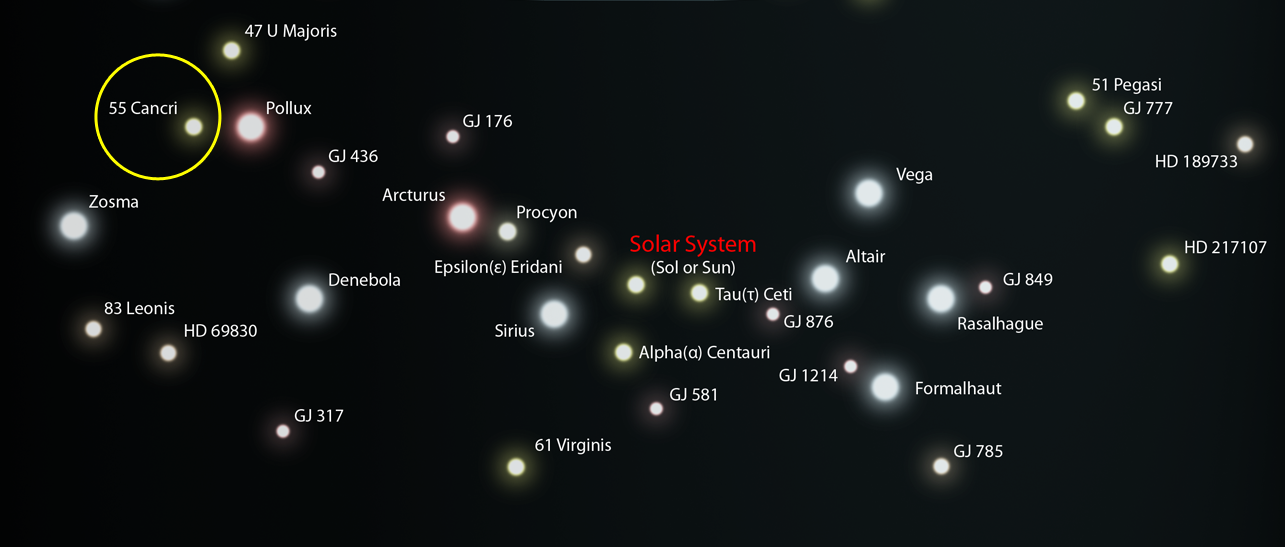Weather on 'super-Earth': Hot, dry and highly poisonous
Meteorologist/Science Writer
Tuesday, February 16, 2016, 5:58 PM - Earth can throw some extreme weather at us at times, but it has nothing on 55 Cancri e. Our first look at a "super-Earth"'s atmosphere has revealed some extremes we'll never have to endure.
Roughly 40 light years away - right in the same interstellar neighborhood as our solar system - there's an alien planet named 55 Cancri e.
Astronomers have been studying this exoplanet ever since it was discovered in 2004, and now the Hubble Space Telescope has revealed even more.

Clipped from "Solar Interstellar Neighborhood", this image show stars within about 50 light years of Earth, including 55 Cancri, the star system where 55 Cancri e resides. Credit: Andrew Z. Colvin/Wikimedia Commons, with edits by S. Sutherland
At over 8 times the mass and twice the diameter of our own world, this "super-Earth" exoplanet is already a place of extremes, and in 2012, a study even suggested that it could be a "diamond planet" due to its carbon-rich profile.
These "super-Earths" are proving to be the most abundant type of planet we are finding around other stars, but now, thanks to observations with Hubble and a new way of analyzing them, a team of astronomers led by the University College London have their very first look at the atmosphere of one of these massive worlds.
"This result gives a first insight into the atmosphere of a super-Earth. We now have clues as to what the planet is currently like and how it might have formed and evolved, and this has important implications for 55 Cancri e and other super-Earths," Giovanna Tinetti, a professor of astrophysics at University College London, UK, said in a statement.
So, what's the weather like there?
55 Cancri e orbits around a Sun-like star, but it's so close to that star that it takes less than 18 hours for it travel around once in its orbit. Thus, while Mercury can get up to 450oC on its Sunward side and Venus tops it at 465oC, temperatures in the atmosphere of 55 Cancri e can reach a sweltering 2,000oC.
With air temperatures in the range you'd expect to see on the surface of a small red dwarf star, it probably comes as no surprise that the atmosphere of 55 Cancri e is extremely dry, with no trace of water vapour.
Furthermore, although 55 Cancri e is a rocky world, somewhat similar to Earth in at least that respect, Hubble has shown that its atmosphere has more in common with a planet like Jupiter or Saturn, since it's mostly comprised of hydrogen and helium.

Artist's impression of 55 Cancri e. Credit: ESA/Hubble, M. Kornmesser
"This is a very exciting result because it’s the first time that we have been able to find the spectral fingerprints that show the gases present in the atmosphere of a super-Earth," Angelos Tsiaras, a PhD student at the University College London, said in a statement. It was Tsiaras, along with Ingo Waldmann and Marco Rocchetto, who developed the new analysis technique that led to this discovery. "The observations of 55 Cancri e’s atmosphere suggest that the planet has managed to cling on to a significant amount of hydrogen and helium from the nebula from which it originally formed."
That's not all, though, Hubble also picked up what looks to be the signature of hydrogen cyanide - an extremely poisonous gas that is lethal to humans at even trace levels.
"If the presence of hydrogen cyanide and other molecules is confirmed in a few years time by the next generation of infrared telescopes, it would support the theory that this planet is indeed carbon rich and a very exotic place," said Jonathan Tennyson, a co-author in the study, who is also at University College London. "Although hydrogen cyanide, or prussic acid, is highly poisonous, so it is perhaps not a planet I would like to live on!"
In a recent International Astronomical Union contest, the star 55 Cancri A was renamed Copernicus, with its five planets, 55 Cancri b, c, d, e and f, named Galileo, Brahe, Lippershey, Janssen and Harriot, respectively. As the letter designations of planets is dependent on which order they were discovered in, 55 Cancri e (Janssen) was the fifth planet discovered, but is the innermost of these worlds. The farthest detected planet in orbit of this star lies at roughly the same distance away as Jupiter is from our Sun.
Although there is the potential for more planets to exist in this system, and possibly even something small and rocky, and having an orbit similar to Earth's, the only potential for a habitable world in this system at the moment would seem to be if 55 Cancri f, now named Harriot. At roughly half the mass of Saturn and orbiting close to the inner edge of Copernicus' habitable zone, any large moons that may be circling this world could have the potential to support life.
Source: Hubble Space Telescope | International Astronomical Union
Watch Below: Exoplanet Wolf 1061c, now the closest confirmed potentially-habitable alien world found, would be a very strange place, indeed.



